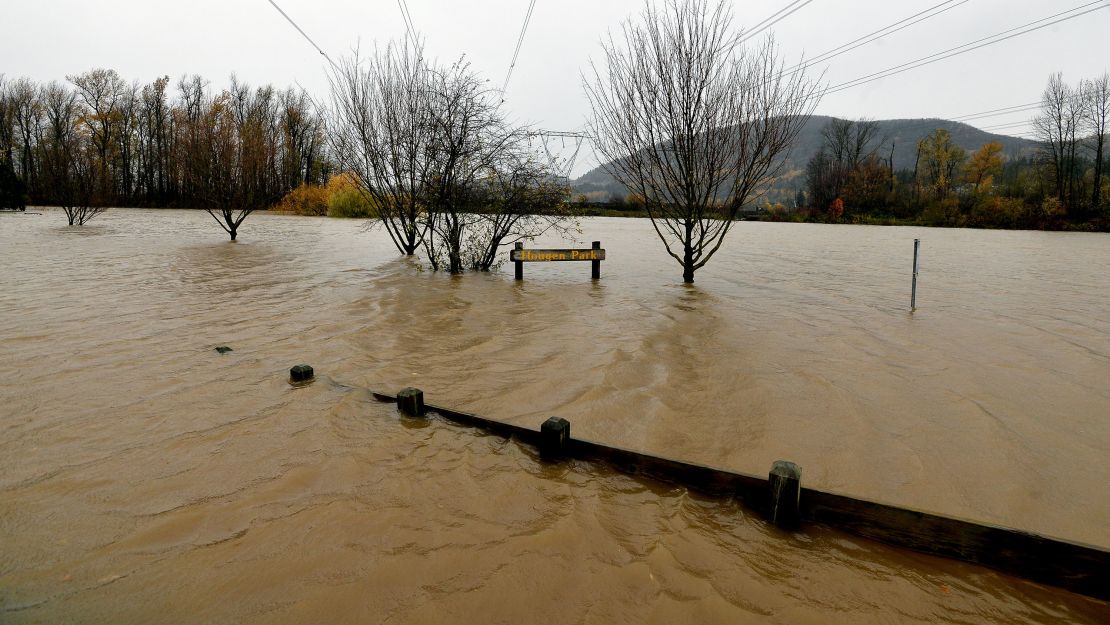The city of Abbotsford in British Columbia, just north of the US border near Vancouver, recorded its hottest day ever in late June when temperatures climbed to 109 degrees Fahrenheit during an unprecedented heat wave.
Just 140 days later, it smashed another record: The city on Sunday observed its wettest day with nearly four inches of heavy rainfall in less than 24 hours.
Human-caused climate change has increased the potential for “weather whiplash,” where conditions whip dramatically between extremes. As warming temperatures change the global water cycle, scientists say seasonal rains will also become more variable: extremely wet years with frequent floods may be punctuated with very dry years including drought and extreme heat.
Around 100 miles north of Abbotsford, mudslides and debris flows on Monday trapped hundreds of people, including 50 children, in cars along highways. At least nine were taken to the hospital with minor injuries following a landslide near the city of Agassiz.
In British Columbia and Washington state, some residents were told to evacuate due to flooding, and many areas experienced power outages. Washington Gov. Jay Inslee declared a state of emergency Monday following days of severe wind and rain.
After months of unrelenting drought across the West, a major atmospheric river — a narrow band of concentrated water vapor in the sky — has brought extreme rainfall, flash floods, damaging winds, debris flow and even landslides throughout the Pacific Northwest over the past few days.

Climate prediction models show “we’re going to have longer dry spells interspersed with bigger storms,” Marty Ralph, the director of the Center for Western Weather and Water Extremes at the Scripps Institution of Oceanography in San Diego, told CNN. “These atmospheric rivers are going to be more potent at times, and it’s not hard to imagine why because the water vapor is the fuel of an [atmospheric river]. If air is warmer, it’s going to carry more water vapor.”
A UN climate report in August found heavy rainfall that used to occur once every 10 years now occurs 30% more frequently. Meanwhile, droughts that may have occurred only once every 10 years or so now happen 70% more frequently around the globe.
Extreme weather hasn’t given the Pacific Northwest and British Columbia much slack in the months leading up to this year’s wet winter season.
A deadly heatwave, which scientists concluded was “virtually impossible” without human-caused climate change, seared the region in late June. Hundreds of people died, and experts called the pernicious heat a mass casualty event.
During that heat wave, the temperature soared to 121 degrees Fahrenheit in Lytton, British Columbia — an all-time record for all of Canada. The next day, a fast-moving wildfire obliterated the village “within minutes.”
“I think it’s somewhat jarring to a lot of people in the area, considering we had a considerable dry stretch this summer where it didn’t rain for a while and we had the heat wave as well,” Maddie Kristell, meteorologist for the National Weather Service (NWS) in Seattle, said. “So kind of bouncing between opposite ends of the spectrum this year, so it’s been pretty dynamic for folks in the area.”
These rapid changes in climate extremes — from heat and drought to high precipitation — could make it harder for societies and communities to mitigate and adapt. In some cases, it could be destructive: according to a 2019 study, atmospheric rivers created an annual average of $1.1 billion annually in flood damage across the West.
But one thing is clear: as the planet warms, “weather whiplash” will only get worse. Ralph said the West should anticipate stronger and larger atmospheric rivers along with longer dry periods — and adapt to these changes.
“That’s essentially what the climate models are showing,” he said. “In some cases, they will be stronger than in the past, and that has implications for water management, such that we’ve got to manage more to the extremes of longer dry periods and bigger storms in between them.”
CNN meteorologist Jennifer Gray contributed to this report.

